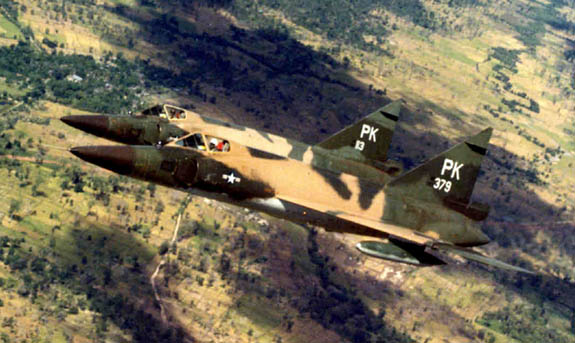WARBIRDS RESOURCE GROUP > VIETNAM > F-102 DELTA DAGGER > PREVIOUS PAGE
Operational History
During the time the F-102A was in service, several new wing designs were used to experiment with the application of increased conical camber to the wings. Ultimately, a design was selected that actually increased elevon area, reduced takeoff speed, improved the supersonic L/D ratio and increased the plane's ceiling to 56,000 feet. A modification was required to the gears due to the wing redesign.
The USAF Air Defense Command had F-102 Delta Daggers in service in 1960 and the type continued to serve in large numbers with both Air Force and Air National Guard units well into the 1970s. George W. Bush, later President of the United States, flew the F-102 as part of his Air National Guard service in the late 1960s and early 1970s.
Vietnam service
The F-102 served in Vietnam, flying fighter patrols and serving as bomber escorts. A total of 15 aircraft were lost in Vietnam: one to air-to-air combat, several to ground fire and the remainder to accidents.
Initially, F-102 detachments began to be sent to bases in Southeast Asia in 1962, when radar contacts that were detected by ground radars were thought to possibly be North Vietnamese Il-28 "Beagle" bombers, which was considered a very credible threat during that time period. F-102s were sent to Thailand and other nearby countries to intercept these aircraft if they indeed threatened South Vietnam at any time.

F-102s over Vietnam, November 1967. (Jack Cook Collection)
Interestingly enough, the F-102 became fairly heavily used in the air-to-ground role. The interceptor was equipped with 24 x 2.75-in FFARs in the fuselage bay doors, and these weapons were used to good effect against various types of North Vietnamese targets. Additionally, heat-seeking Falcon missiles used in conjunction with the F-102s nose-mounted IRST (Infrared Search & Track) were employed on night time harassment raids along the Ho Chi Minh trail. This is likely the only time an air-to-air missile has been used for air-to-ground operations.
Operations with both the F-102A and TF-102A two-seater (which was used in a Forward Air Control role because its two seats and 2.75-in. rockets offered good versatility for the mission) in Vietnam until 1968 when all F-102 aircraft were sent back to the United States.
Later use
In 1973, six aircraft were converted to target drones as QF-102A and later PQM-102 series, simulating MiG-21s. This began a program where hundreds of F-102s were converted for use as target drones for F-4 and F-106 aircraft as well as later F-15 aircraft and testing of the US Army's Patriot missile system.
Some F-102As were configured to accommodate a single AIM-26 Super Falcon in each side bay in lieu of the conventional 2 x AIM-4 Falcons.
The F-102 and TF-102 were exported overseas to both Turkey and Greece, with those aircraft seeing combat missions during the 1974 Turkish invasion of Cyprus. There have been claims of air combat between Greek F-5s and Turkish F-102s. The Greeks claimed to have shot down two F-102s while the Turks claim to have shot down an F-5; however, both sides deny losses. The F-102 was finally retired from both of those air forces in 1979. The F-102 left US service in 1976, while the last PQM-102 drone was expended in 1986. No F-102s remain in flyable condition today although many can be seen at museums.
Sources:
Wikipedia: F-102 Delta Dagger
WARBIRDS RESOURCE GROUP > VIETNAM > F-102 DELTA DAGGER > PREVIOUS PAGE
